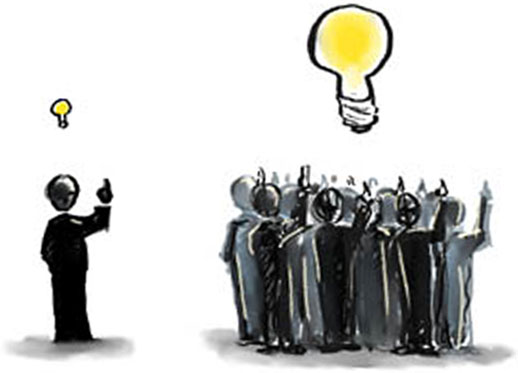by Gord Hotchkiss, , Featured Contributor, April 19, 2016

I thought it would be interesting to rerun this column from 2014 on the day of the New York primary — which, given the context, is raising relevant concerns about the efficacy of our current notion of democracy. The democratic process is, philosophically, the equivalent of the wisdom of crowds. Add to this multiple layers of political machination and the extreme ideological polarization that is currently true in the U.S., and we may have a situation where we have to revisit what Winston Churchill said in 1947: “Democracy is the worst form of government, except for all the others.”
Since James Surowiecki published his book “The Wisdom of Crowds,” the common wisdom is that we are commonly wise. In other words, if we average the knowledge of many people, we’ll be smarter than any of us would be individually. And that is true — to an extent. But new research suggests that there are group decision dynamics at play where bigger (crowds) may not always be better.
A study by Iain Couzin and Albert Kao at Princeton suggests that in real-world situations, where information is more complex and spotty, the benefits of crowd wisdom peak in groups of 5 to 20 participants, and then decrease after that. The difference comes in how the group processes the information available to them.
In Surowiecki’s book, he uses the famous example of Sir Francis Galton’s 1907 observation of a contest where villagers were asked to guess the weight of an ox. While no individual correctly guessed the weight, the average of all the guesses came in just one pound short of the correct number.
But this example has one unique characteristic that would be rare in the real world: every guesser had access to the same information. They could all see the ox and make their guess. Unless you’re guessing the number of jellybeans in a jar, this is almost never the case in actual decision scenarios.
Couzin and Kao say this information “patchiness” is the reason why accuracy tends to diminish as the crowd gets bigger. In most situations, there is commonly understood and known information, which the researchers refer to as “correlated information.” But there is also information that only some of the members of the group have, which is “uncorrelated information.”
To make matters even more complex, the nature of uncorrelated information will be unique to each individual member. In real life, this would be our own experience, expertise and beliefs. To use a technical term, the correlated information would be the “signal” and the uncorrelated information would be the “noise.” The irony here is that this noise is actually beneficial to the decision process.
In big groups, the collected “noise” gets so noisy, it becomes difficult to manage — and so it tends to get ignored. It drowns itself out. The collective focuses instead on the correlated information.
In engineering terms, this higher signal-to-noise ratio would seem to be ideal, but in decision-making, it turns out a certain amount of noise is a good thing. By focusing just on commonly known information, the bigger crowd oversimplifies the situation.
Smaller groups, in contrast, tend to be more random in their make-up. The differences in experiences, knowledge, beliefs and attitudes, even if not directly correlated to the question at hand, have a better chance of being preserved. They don’t get “averaged” out as they would in a bigger group. And this “noise” leads to better decisions if the situation involves imperfect information. Call it the averaging of intuition, or hunches. In a big group, the power of human intuition gets sacrificed in favor of the commonly knowable. But in a small group, intuition is preserved.
In the world of corporate strategy, this has some interesting implications. Business decisions are almost always complex and involve imperfectly distributed information.
This research seems to indicate that we should carefully consider our decision-making units. There is a wisdom-of-crowds benefit — as long as the crowd doesn’t get too big. We need to find a balance where we have the advantage of different viewpoints and experiences, but the aggregate “noise” doesn’t become unmanageable.
MediaPost.com: Search Marketing Daily
(106)